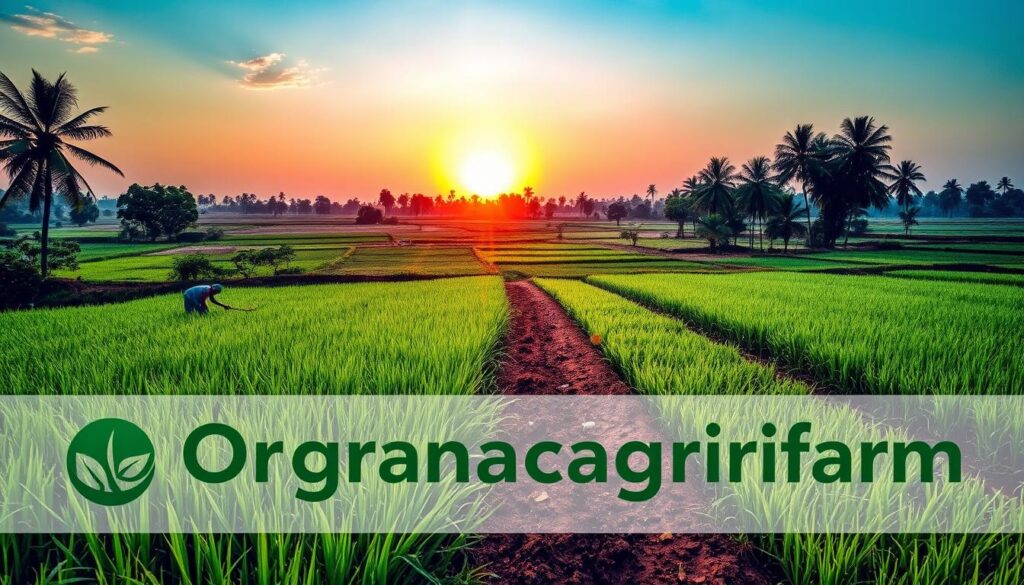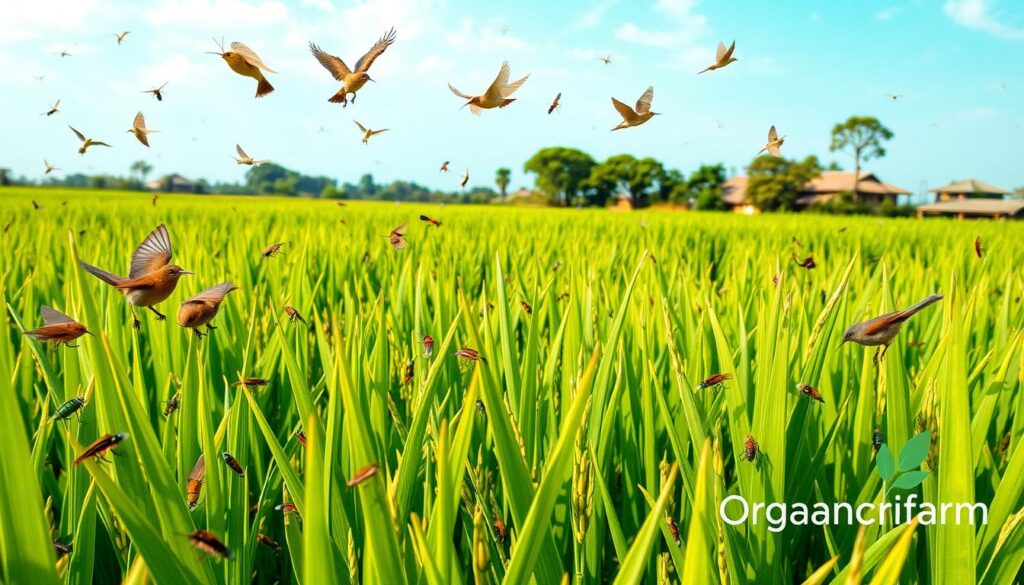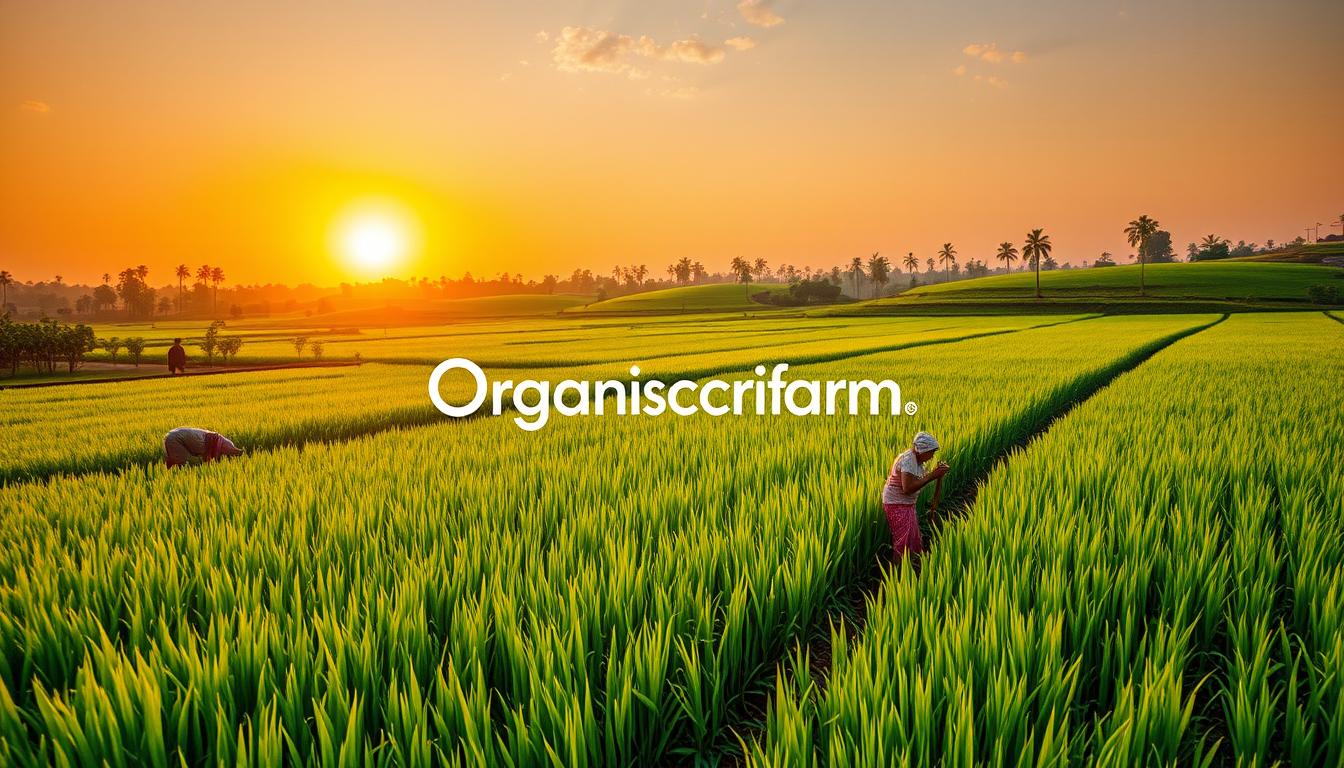We are excited to share about organic rice farming. It’s key for sustainable agriculture in India. Rice is a big food source worldwide, and organic farming helps the planet.
Organic rice farming uses natural stuff instead of chemicals. It follows strict rules to be called organic. This makes it great for those who want to help the environment.
Organic rice farming is good for the planet. It cuts down on bad air and helps more plants grow. In India, a lot of people eat rice, so it’s very important.
Organic farming helps farmers too. It uses natural ways to keep pests away and makes the soil better. This can really help Indian farmers.
Organic farming is better for the environment. Rice farming uses a lot of water, but organic farming can use less. This helps the planet and supports farming that’s good for the earth.
We’ll talk more about how to farm rice in a way that’s good for the planet. We’ll look at saving water and making the soil better.
Key Takeaways
- Organic rice farming promotes sustainable agriculture and reduces environmental impacts.
- Sustainable rice farming practices can reduce greenhouse gas emissions and promote biodiversity.
- Natural fertilizers and pest management techniques are essential components of organic rice farming.
- Close to 60 percent of India’s population depends on rice for sustenance.
- Organic rice farming involves adhering to specific certification standards.
- Water conservation methods are crucial for sustainable rice cultivation.
Understanding Organic Rice Farming in India
Exploring organic rice production is key. India’s 80% population depends on agriculture. Organic farming is a natural, green choice.
India’s rice production has grown a lot. But, this growth worries the environment. Organic farming helps the soil and keeps nature diverse.
Organic rice farming is good for the soil and crops. It also helps the planet. We should support this green farming in India.
Traditional vs Modern Organic Methods
Traditional organic farming uses natural stuff like compost. Modern farming might use new tech like precision farming. Each has its own benefits and downsides.
Current State of Organic Rice Production
India’s organic rice farming is doing well. In 2020-2021, India sent out 46,30,463.14 MT of organic basmati rice. This shows people want organic rice more.
Essential Components of Sustainable Rice Cultivation
We know how important sustainable rice cultivation is. It helps us care for our planet. We use organic farming practices to keep the soil healthy and water in check. This way, we avoid harming the environment and people’s health.
Important parts of sustainable rice cultivation are crop rotation and using organic fertilizers. These steps keep the soil rich and protect it from erosion. Also, rice farming best practices like laser land leveling save water and cut down on work.
Choosing environmentally friendly rice farming helps us grow better crops. It also makes farming kinder to our planet. The Sustainable Rice Platform (SRP) guides us in these efforts, focusing on farm management and water use.
Here are some good things about sustainable rice farming:
- It makes crops better and more plentiful
- It’s gentler on our planet
- It saves water and soil
- It helps nature and keeps it diverse

Together, we can make rice farming better for our planet. This way, we help ensure everyone has enough food.
| Practice | Benefits |
|---|---|
| Organic farming | Soil stays healthy, less chemicals |
| Crop rotation | Helps nature, stops soil from washing away |
| Zero tillage | Saves water, less work needed |
Natural Pest Management Techniques
We use natural pest control in farming to protect the environment. Organic pest management uses many methods. These include biological control, traditional Indian practices, and planting crops together.
Some pests in rice fields are planthoppers and leafhoppers. They can cause hopperburn and lower yields. Farmers use different ways to control these pests, like cultural and biological methods.
Using an Integrated Pest Management (IPM) strategy is key for organic rice farming.
Traditional Indian methods, like using egg parasitoids, can fight White Backed Planthopper. Neem seed extract and oil can also control pests in rice. Draining the field for a few days can help with White backed plant hopper.
Here are some eco-friendly pest control methods:
- Biological control methods, such as releasing natural predators or parasites of the pest
- Companion planting strategies, which involve planting certain crops together to deter pests
- Cultural methods, such as keeping fields free from weeds and using crop rotation
These methods help lower chemical pesticide use. They support sustainable rice farming.

By using these natural methods, farmers can lessen their environmental impact. Organic and eco-friendly pest control are vital for our planet’s health.
| Pest | Control Method |
|---|---|
| Planthoppers | Biological control methods, cultural methods |
| Leafhoppers | Companion planting strategies, biopesticide approaches |
Soil Preparation and Management
Soil health is key for growing organic rice. We add organic soil amendments to make the soil better. This makes the soil healthier for the rice.
We also use green ways to get the soil ready. Like puddling and leveling the land. These steps help keep water in, kill weeds, and make the soil soft for planting.
Good soil care means healthier soil, more nutrients, and more life. We start by tilling the soil with ploughing, harrowing, and puddling. We also use special helpers like Azospirillum to make the soil better.
Using green ways to prepare the soil helps the planet and grows better rice. The System of Rice Intensification (SRI) is a great example. It makes the soil better and grows more rice per acre.
Water Conservation Methods in Organic Rice Farming
Organic rice farming needs water-saving methods. This is key in areas where rice farming is a main job. Using eco-friendly ways to manage water is very important.
Old water systems have been around for a long time. But, new irrigation methods save more water. For example, SRI and AWD can use 15-30% less water without losing yield. Also, growing rice directly can save up to 75% of water, but it might lower yield by 10%.
Using water-saving methods in organic rice farming helps a lot. It cuts down on water use and seed needs. It can also make crops grow better. Most of the world’s freshwater is for irrigation, with half for rice. Eco-friendly irrigation can lessen rice farming’s harm to the environment and help feed more people.
Benefits of Water Conservation in Organic Rice Farming
- Less water used: Eco-friendly irrigation can save 40-50% of water compared to old ways.
- Bigger crop yields: Saving water can make rice crops grow 50-100% more.
- Better water use: Saving water in farming makes it more efficient, needing less water for rice.
By saving water in farming and using organic methods, we can make rice farming better. This helps feed the world’s growing population.
Economic Benefits and Market Opportunities
The organic rice market is growing fast. It was worth $7.8 billion in 2023. By 2034, it’s expected to hit $12.0 billion, growing 4.1% each year. This growth comes from people wanting healthier, green food choices. Farmers and producers can make good money by joining this market.
Big names like Doguets Rice and Randall Organic are leading the way. They offer new organic rice products. These include special varieties and easy-to-use items for busy people.
In the Asia-Pacific area, organic rice is getting more popular. This is because people know it’s good for them. They also have more money to spend and governments support organic farming. Here are some important facts about the organic rice market:
| Category | Statistic |
|---|---|
| Global Organic Rice Market Size (2023) | $7.8 billion |
| Projected Growth Rate (2024-2034) | 4.1% CAGR |
| Key Players | Doguets Rice, Randall Organic, Sanjeevani Organics, Kahang Organic Rice, Riceselect, Texas Best Organics, STC Group, Yinchuan, Urmatt, and Vien Phu |
The organic rice market is a big chance for farmers and producers. They can make money and help the planet.
Conclusion: The Future of Sustainable Rice Farming in India
The future of rice farming in India looks bright for those using green methods. More people want organic food, which makes farmers switch to organic farming. The government is helping farmers by supporting them in going organic, which is making farming better and more profitable.
New tech in farming, like special sprayers, is making things better and greener. These sprayers help farmers use organic stuff right. There are many types of sprayers now, helping organic farmers a lot.
But, organic farming has its tough parts, like it costs more and takes more work. But, there are ways to fix these problems. Things like government help, better farming ways, and new tools can make farming better. We’re looking forward to seeing more green farming in India.
